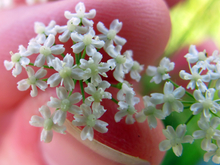Quick facts
Burnet saxifrage is an invasive species.
-
Invader of disturbed areas, such as woodlands and grasslands.
-
High seed production leads to quickly colonizing open environments.
Burnet saxifrage should be reported. The Minnesota Department of Natural Resources provides detailed recommendations for reporting invasive species.
How to identify burnet saxifrage
Burnet saxifrage (Pimpinella saxifraga) is two to three feet tall; very similar in appearance to wild carrot (another non-native species).
Stem
-
Densely covered in short hairs; rarely branched.
Leaves
- Burnet Saxifrage leaves are alternate, few and widely spaced.
- The leaves are arranged in a pinnate pattern.
- They are covered in short hairs and wrap around stem at leaf base.
- Leaves become smaller as they ascend up the plant.
- Deeply lobed near the top.
- Lower leaves look similar to wild parsnip rosettes.
Flowers
- Flat clustered umbels made up of 7–20 groups of 10–20 flowers.
- Flowers are small, one sixth of an inch across, with five petals and a pair of styles at the top.
- Flowers are generally white, but occasionally pinkish.
Fruit
- Flattened oval pod with slight ribs. Less than one eighth of an inch long.
Seeds
-
Two small seeds are produced from each fruit pod.
Roots
- Fibrous taproot.
Reviewed in 2019




